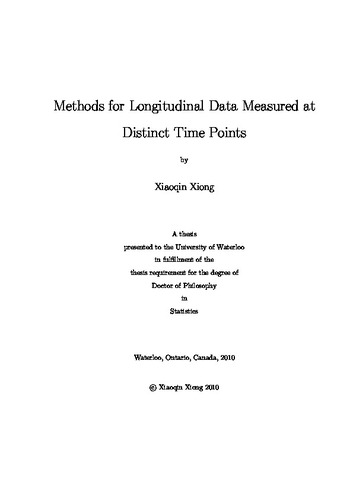| dc.description.abstract | For longitudinal data where the response and time-dependent
predictors within each individual are measured at distinct time
points, traditional longitudinal models such as generalized linear
mixed effects models or marginal models cannot be directly applied.
Instead, some preprocessing such as smoothing is required to
temporally align the response and predictors.
In Chapter 2, we propose a binning method, which results in equally
spaced bins of time for both the response and predictor(s). Hence,
after incorporating binning, traditional models can be applied. The
proposed binning approach was applied on a longitudinal hemodialysis
study to look for possible contemporaneous and lagged effects
between occurrences of a health event (i.e., infection) and levels
of a protein marker of inflammation (i.e., C-reactive protein). Both
Poisson mixed effects models and zero-inflated Poisson (ZIP) mixed
effects models were applied to the subsequent binned data, and some
important biological findings about contemporaneous and lagged
associations were uncovered. In addition, a simulation study was
conducted to investigate various properties of the binning approach.
In Chapter 3, asymptotic properties have been derived for the fixed
effects association parameter estimates following binning, under
different data scenarios. In addition, we propose some
leave-one-subject-out cross-validation algorithms for bin size
selection.
In Chapter 4, in order to identify levels of a predictor that might
be indicative of recently occurred event(s), we propose a
generalized mixed effects regression tree (GMRTree) based method
which estimates the tree by standard tree method such as CART and
estimates the random effects by a generalized linear mixed effects
model. One of the main steps in this method was to use a
linearization technique to change the longitudinal count response
into a continuous surrogate response. Simulations have shown that
the GMRTree method can effectively detect the underlying tree
structure in an applicable longitudinal dataset, and has better
predictive performance than either a standard tree approach without
random effects or a generalized linear mixed effects model, assuming
the underlying model indeed has a tree structure. We have also
applied this method to two longitudinal datasets, one from the
aforementioned hemodialysis study and the other from an epilepsy
study. | en |

